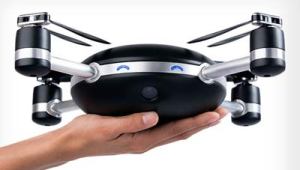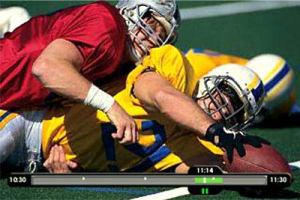 THE POWER OF THE ‘GET OUT!’ MOMENT
THE POWER OF THE ‘GET OUT!’ MOMENT
Every once in a while, we come across some aspect of a new product that makes us act like Elaine in TV’s Seinfeld, violently exclaiming, “GET OUT!” with disbelief accompanied
by a hearty push-off.
 Elaine aptly demonstrated many of these ‘shock and awe’ moments throughout Seinfeld episodes which product developers would do well to use as inspiration. Shock and awe during user experience can be powerful. Think of it as an amped up version of the ‘surprise and delight’ often talked about by developers and reviewers of products. But how can we overtly design for shock and awe, and should we even attempt to?
Elaine aptly demonstrated many of these ‘shock and awe’ moments throughout Seinfeld episodes which product developers would do well to use as inspiration. Shock and awe during user experience can be powerful. Think of it as an amped up version of the ‘surprise and delight’ often talked about by developers and reviewers of products. But how can we overtly design for shock and awe, and should we even attempt to?
WHY AIM TO SHOCK AND AWE?
The legendary science fiction author Arthur C. Clarke famously penned: “Any sufficiently advanced technology is indistinguishable from magic.” This has long been a belief of many technologists, that their work rises to the level of being magical. And magic is at the root of shock and awe. It’s such a common trope in Silicon Valley, I’ve worked at two different startups that each separately named their conference room ‘Houdini,’ and a third which named their SaaS service “Magic.” Whether this bit of arrogance (i.e. that our code is more magical than theirs) is deserved or not isn’t the point. The tech ‘magic’ which foments shock and awe is extremely useful as a business tool if architected properly and embraced by the designers, engineers, product managers and marketers who are creating a new product or service. If the entire development team is tasked with making shock and awe an imperative, then it is much more likely to be a fundamental part of the user experience, and ultimately part of the brand essence of the company. Done well, shock and awe can be worth hundreds of press articles, millions of free prospect impressions, and can kick start product launch momentum putting your company on the map.
THE SHOCK AND AWE CONTINUUM
The extent to which a development team is able to shock and awe their users in a beneficial way depends greatly on the type of product or service they have created. It’s important to understand that ‘shock and awe’ exists on a continuum with ‘boredom and disdain’ at the other end and ‘surprise and delight’ somewhere in the middle. It’s not always possible to architect shock and awe into a product experience, but at the very least there should be some surprise and delight, and hopefully never boredom and disdain.
A great example of surprise and delight was delivered with my order of iPhone accessory camera lenses from Photojojo.com. In the box along with my lenses was a small plastic toy dinosaur. This made me grin, mainly because of what a non sequitur it was. But what tipped me over into ‘surprise and delight’ was that they listed the toy on the invoice as “Rawwwwwr!…$0.00 for 1.”
That made me smile and embrace the playfulness that this e-tailer was trying to imbue into their brand. I would suggest that their ten cent dinosaur lagniappe achieved its goal of driving engagement since I have purchased from Photojojo.com many times since. In a world full of dour corporations, a ten cent dinosaur can go a long way.
However, throwing a cheap toy into a shipping carton is far from the beneficial shock and awe that can help a product a) get noticed, b) make people care, and c) create product love (see my article “Startup Product Success: A Framework for Entrepreneurs”). A great example of shock and awe I came upon recently is Lily.  At first glance the four propellers make you think Lily is a radio controlled quadcopter. But with Lily’s website URL ‘www.lily.camera,’ their tagline ‘Camera. Reinvented.’ and ‘world’s first throw and shoot camera’ messaging, they are going out of their way to position and differentiate Lily as a ‘flying camera’ and not one of the dozens of camera-toting drones now available. But the ‘shock and awe’ moments Lily architected into their user experience are best seen in their crowdfunding video, which has over 10 million views.
At first glance the four propellers make you think Lily is a radio controlled quadcopter. But with Lily’s website URL ‘www.lily.camera,’ their tagline ‘Camera. Reinvented.’ and ‘world’s first throw and shoot camera’ messaging, they are going out of their way to position and differentiate Lily as a ‘flying camera’ and not one of the dozens of camera-toting drones now available. But the ‘shock and awe’ moments Lily architected into their user experience are best seen in their crowdfunding video, which has over 10 million views.  In the video, the Lily user merely tosses the machine into the air and it starts flying, then autonomously following the user while capturing video. If that wasn’t shocking enough, the next shot ups the ante and has the user throwing his $800 flying camera over the railing of a bridge, whereupon Lily flies up and starts filming.
In the video, the Lily user merely tosses the machine into the air and it starts flying, then autonomously following the user while capturing video. If that wasn’t shocking enough, the next shot ups the ante and has the user throwing his $800 flying camera over the railing of a bridge, whereupon Lily flies up and starts filming.  And if this still wasn’t shocking enough, the next user casually tosses Lily into a river, which triggers it to fly up out of the water and follow a kayaker downstream.
And if this still wasn’t shocking enough, the next user casually tosses Lily into a river, which triggers it to fly up out of the water and follow a kayaker downstream.
Lily is a veritable tour-de-force of shock and awe for anyone interested in selfie videos. Their crowdfunding video leaves the audience screaming “GET OUT!” and has created 60,000 pre-orders worth $34 million dollars. This proved that Lily also got their fans to say “Shut up, and take my money!” the gold standard of shock and awe results. Lily employed killer design, a compelling story, and most of all an epic user experience to create shock and awe in their product. This in turn got Lily noticed, made people care, and created product love—all before the product had even shipped or been reviewed.
HOW TO SHOCK AND AWE
There is no one perfect method for creating shock and awe. It is probably best described as ‘You’ll know it when you see it.’ Here are seven steps that can help structure your team’s efforts to create shock and awe in their product.
1. Make ‘Shock and Awe’ A Core Product Requirement
The most important step in creating shock and awe for a product is to communicate executive sponsorship for this effort and get everyone associated with its development to understand that this is a core product requirement. The team will likely need to spend significant time coming up with how to fulfill this requirement and you may need to include people not normally involved in writing product requirements. Demonstrating top-level commitment is vital to getting this done.
2. Gain Outside Advice
Who better to involve in this effort than your marketers and salespeople who will need to actually wow and sell their audiences? Some of the best ideas may come from people outside the development group but still inside the company. You may also get excellent shock and awe ideas from company advisors or consultants, people who aren’t tainted by internal company-think or burdened with the task of actually developing the hardware or software that will deliver the shock and awe. It is very easy for inside people to say, “That would be too hard and expensive,” summarily shooting down an idea based on their belief of cost structure. You need to find people who are passionate about your product category and ask them, “What would make this kind of product the coolest thing ever?”
3. Ensure That The Shock and Awe Is In Lockstep With Product Positioning
In many companies, the marketing people don’t integrate well with the product people. So the ‘story’ told by the marketers is just a compilation and regurgitation of features and benefits that resulted from the original product requirements they had no hand in creating. Product development isn’t supposed to be like this, but all too often it is. What if both teams started with delivering shock and awe as the prime product requirement, even before product positioning is considered? In the case of the Lily flying camera, being able to throw it into the air and start flying itself must have been one of the primary product goals. From that highly unique product requirement, other requirements must have followed: e.g. 1) no landing skids, 2) must land gently on an upturned palm, 3) auto on/off video, 4) smooth surfaces, 5) small enough for the rotors not to hit the operator when landing, and so on. When marketing and product people work together seamlessly, better products result, and shock and awe becomes possible.
SIDEBAR: PRODUCT POSITIONING AND SHOCK AND AWE
I was speaking to a friend who is an executive at a large drone manufacturer. From his viewpoint, what Lily is trying to do with the “throw and shoot” feature was not easy to accomplish technically and probably was not worth the time and effort. I couldn’t disagree more, at least for Lily. Adopting ‘toss and go’ as a prime product requirement not only created shock and awe that differentiated Lily from the myriad of other drone manufacturers, it allowed them to position themselves as the world’s only flying camera. That is a significantly different product position and user experience than a hobbyist drone, which is more like a flying R/C car. Of course it only makes sense to do this if the market segment of people who want flying selfie cameras is large enough to support a business. I think $34M in pre-orders has answered that question.
4. Look At The Competition
Are your competitors shocking and awe-ing the world? If not, why not? What would you suggest for your competitor to bring shock and awe to their offering? Or if you have no direct competition, look at an analogous product. What single thing can you envision that might change the way their product is perceived? How is their product presented or demonstrated? What is one core feature that would differentiate it from other companies? Get curious and practice applying shock and awe think to other products before applying it on your own.
5. Delivering Shock And Awe
Many products don’t lend themselves to the type of in-person demo that will create shock and awe. Julia Child may have created a fantastic meal on her 1960s TV show, but the only way she could deliver on her ‘demo’ was to have the final product already baked and ready for presentation the instant her prep work was done: “Et voilà and bon appetite!” Fine for a cooking show, but much more difficult to communicate for a tech product company. On the other hand, TiVo was almost the perfect shock and awe technology of the late 1990s, allowing users to:
way she could deliver on her ‘demo’ was to have the final product already baked and ready for presentation the instant her prep work was done: “Et voilà and bon appetite!” Fine for a cooking show, but much more difficult to communicate for a tech product company. On the other hand, TiVo was almost the perfect shock and awe technology of the late 1990s, allowing users to: 
Pause. Live. TV. GET OUT!
TiVo’s promise was so shocking at the time that it had the problem of communicating a value proposition that was almost unbelievable in a whole new product category. A great problem to have, but a problem nonetheless.
One critical element you will need to know is what communication vehicle you will use to communicate shock and awe. Will you be advertising on television? Will demos be given by your salespeople in front of business buyers? Will a YouTube video get across the shock and awe? Could there be an interactive online experience that creates a “GET OUT!” moment? Remember that it’s not enough to architect shock and awe without carefully thinking through how your organization will deliver it to your customers.
6. Testing Shock and Awe
You’ll also need to decide whether you’ve successfully created the “GET OUT!” moment you intended. How will you determine that? Will it be internal decision-making, friends and family, or outside consultants? Will you use structured focus groups or an online beta? Whichever method you choose, size the testing effort so it is commensurate with the importance of your product launch.
7. Funding Shock and Awe
Here is the ugly truth, accomplishing shock and awe will cost more than most entrepreneurs are willing to allocate to a development budget. And it will take significant vision and people management to make it happen. That doesn’t mean you can’t still make it a core product requirement. It just means you may need to shift your thinking and understand that investment in shock and awe needs to be shared between the engineering, product management, marketing, advertising, public relations, and sales budgets. Done well, each of these functions in the company will benefit significantly from product shock and awe.
THE PROMISE OF SHOCK AND AWE
The problem with creating shock and awe through a ‘sufficiently advanced technology that is indistinguishable from magic’ is that with it comes an implied promise. These days, crowdfunding sites raise millions of dollars from regular people for products that don’t yet exist, and there is a clear danger of overpromising and under delivering on user experiences demonstrated by slick marketing videos. It’s vital for product developers to internalize that the only sin worse than eliciting boredom and disdain is failing to deliver on promised shock and awe. Consumers can be a fickle bunch, so be precise about the magic you promise. [Update on the Lily flying camera that never was, from Recode Jan. 2017]
Learning how to create shock and awe takes thoughtful consideration, collaborative discussion, and practice. And achieving it isn’t always possible to the degree you might desire. But you should also understand there are other ways to shock and awe as a company. Here are just a few very effective examples:
– Have a human answer the company’s main telephone line without a menu tree
– Empower customer service agents to solve customer problems without an escalation
– Have the CEO respond to customers on the company’s Facebook page or Twitter feed
– Include a toy dinosaur in your product cartons…oops, that one’s already been done. ; )
A FEW PRODUCTS THAT HAVE SHOCKED AND AWED
Here are some of my favorite shock and awe demo videos. I’ve thrown in some old school product demos as well just to remind you that ‘GET OUT!’ moments have been around for a long time.
Lily: ‘throw and shoot’ flying camera
TiVo: ‘pause’ live TV
Tesla: disappearing door handles
Tesla: ‘insane mode’ acceleration
Jawbone: ‘noise is nothing’ demo
ShamWow: unbelievable absorbance
OxiClean: shocking cleaning power
PARTING SHOT
One final thought. If a company doesn’t consider shock and awe when designing their product they either don’t understand marketing or are just being plain lazy. It may not always be possible to accomplish shock and awe in a product, but NOT trying to achieve it comes at the cost of paying people to take notice of, and care about, what you are selling. Instead, what if you architected shock and awe into your product and the world spread your story for you, and made it easy to drive awareness and sales conversion? “GET OUT!” ::
© 2016 Peter Radsliff – All Rights Reserved – All third-party images, trademarks and copyrighted works are the property of their respective owners and mention here does not imply any endorsement unless specifically stated as such.
NOMINATE YOUR FAVORITE SHOCK AND AWE PRODUCT
If you have a favorite product that demonstrated shock and awe, please name it in the comments below:






